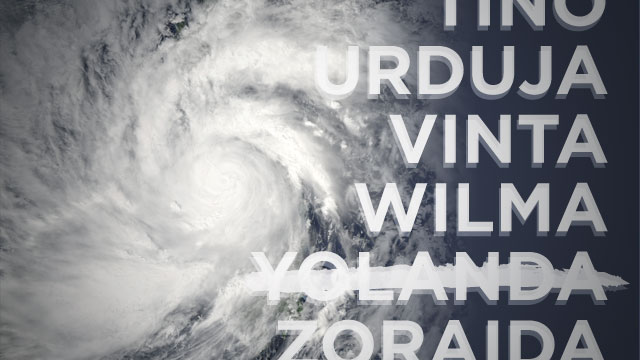SUMMARY
This is AI generated summarization, which may have errors. For context, always refer to the full article.
 MANILA, Philippines (UPDATED) – The national weather bureau will decommission “Yolanda” from the list of names for Philippine tropical cyclones, after it caused massive destruction in the Visayas.
MANILA, Philippines (UPDATED) – The national weather bureau will decommission “Yolanda” from the list of names for Philippine tropical cyclones, after it caused massive destruction in the Visayas.
“Certainly, it will be retired,” said weather forecaster Alvin Pura of the Philippine Atmospheric, Geophysical and Astronomical Services Administration (PAGASA).
He explained that Typhoon Yolanda (Haiyan) has met the criteria for a storm name’s retirement: at least 300 deaths or P1 billion worth of damage in crops and infrastructure.
PAGASA said Yolanda will soon be replaced by a new name that also starts with the letter Y.
As of Friday night, November 22, the death toll from Typhoon Yolanda was at over 5,000, according to the National Disaster Risk Reduction and Management Council (NDRRMC). It also reported that the total cost of damage had reached P12.66 billion. Yolanda is now among the deadliest typhoons that have struck the Philippines.
Yolanda is also the strongest storm in world history to make landfall, after recording maximum sustained winds of 315 km/h when it hit Guiuan, Eastern Samar, on Friday, November 8. (READ: Yolanda and the world’s strongest storms)
It then made 5 more landfalls across the islands of the Visayas and Palawan before exiting the Philippine Area of Responsibility (PAR) on Saturday, November 9.
Retiring storm names
Yolanda is the third storm name in 2013 to be retired from PAGASA’s list, after Labuyo in August and Santi in October. Labuyo (Utor) killed 11, but inflicted P1.42-billion worth of damage to crops and infrastructure.
Meanwhile, Santi (Nari) claimed 15 lives and caused P3.3 billion worth of damage.
According to PAGASA, it waits for the final report of the NDRRMC before officially retiring a storm name. Labuyo’s name was decommissioned a week after it left the PAR.
Before Santi, the 10 latest typhoon names retired by PAGASA were:
- Pablo (2012), replaced by Pepito
- Sendong (2011), replaced by Sarah
- Pedring (2011), replaced by Perla
- Mina (2011), replaced by Marilyn
- Juaning (2011), replaced by Jenny
- Bebeng (2011), replaced by Betty
- Juan (2010), replaced by Jose
- Pepeng (2009), replaced by Paolo
- Ondoy (2009), replaced by Odette
- Cosme (2008), replaced by Carina
How PAGASA names storms
When a weather disturbance enters the PAR, PAGASA chooses from a set of names assigned for the calendar year. There are 140 names, grouped into 4 sets of 25 regular names and 10 auxiliary names, with each set used every 4 years.
These names were chosen from thousands of submissions to a contest PAGASA conducted in 1999. First used in 2001, the new list replaced a roster of female Filipino nicknames ending with “ng,” like Rosing and Huaning.

The regular names start with every letter of the alphabet except for the letter X. The first storm in a calendar year that enters the PAR is given a name that starts with the letter A – in this year’s case, Auring.
Every storm thereafter is assigned the next name on the current set’s list. For the following calendar year, PAGASA uses the next set of regular names and returns to the letter A – in 2014’s case, Agaton.
The auxiliary names are arranged alphabetically from A to J, and used only when all regular names have been exhausted within a calendar year.
This year, since Zoraida has been used for the tropical depression that entered the PAR shortly after Yolanda, the next weather disturbance will be named Alamid, the first name in the auxiliary list.
International names
A weather disturbance also obtains an international storm name from the Japan Meteorological Agency (JMA) once it reaches tropical storm strength (pegged at 63 km/h) and develops in the northwestern part of the Pacific Ocean (between 180° and 100°E longitude to the north of the equator).
Asked why the Philippines has its own naming system apart from JMA’s, Pura of PAGASA explained that the weather bureau also gives names to tropical depressions, which have maximum winds speeds below 63 km/h – not enough for JMA to give it an international name.
Giving a local name to an incoming weather disturbance, whether it is weak or strong, also serves as a “signal” for Filipinos to prepare for it, Pura said.
There are 140 names in the JMA list, with 10 coming from each of the 14-member nations of the UN Economic and Social Commission for Asia and the Pacific (ESCAP)/World Meteorological Organization (WMO) Typhoon Committee: Cambodia, China, Democratic People’s Republic of Korea (North Korea), Hong Kong, Japan, Laos, Macau, Malaysia, Micronesia, the Philippines, South Korea, Thailand, United States, and Vietnam.
Unlike the PAGASA naming system, JMA’s exhausts all 140 names, grouped into 10 subsets, before recycling the list. Each ESCAP/WMO member-nation submitted one name per subset. JMA’s naming system has no auxiliary list. (READ: ‘Haiyan,’ 3 others removed from int’l typhoon names list)
The next Philippine-submitted name on the JMA list is Hagibis, followed by Hagupit, Molave, Lupit, Malakas, Talas, Talim, Maliksi, Cimaron and Danas. – Rappler.com
Do you have any interesting, intelligent, incredible, or even insane and inane questions in mind? Email us at research@rappler.com, and let Rappler IQ provide the answers.
Add a comment
How does this make you feel?
There are no comments yet. Add your comment to start the conversation.